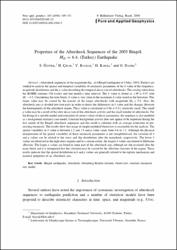| dc.contributor.author | Öztürk, Serkan | |
| dc.contributor.author | Çınar, Hakan | |
| dc.contributor.author | Bayrak Yusuf | |
| dc.contributor.author | Karslı, Hakan | |
| dc.contributor.author | Daniel, Guillaume R. | |
| dc.date.accessioned | 2014-09-11T09:30:23Z | |
| dc.date.available | 2014-09-11T09:30:23Z | |
| dc.date.issued | 2008 | |
| dc.identifier.uri | https://hdl.handle.net/20.500.12440/135 | |
| dc.identifier.uri | https://link.springer.com/article/10.1007/s00024-008-0300-5?utm_source=getftr&utm_medium=getftr&utm_campaign=getftr_pilot | |
| dc.description.abstract | Aftershock sequences of the magnitude MW ¼6.4 Bingo¨l earthquake of 1 May, 2003 (Turkey) are studied to analyze the spatial and temporal variability of seismicity parameters of the b value of the frequencymagnitude distribution and the p value describing the temporal decay rate of aftershocks. The catalog taken from the KOERI contains 516 events and one month’s time interval. The b value is found as 1.49 ± 0.07 with Mc ¼3.2. Considering the error limits, b value is very close to the maximum b value stated in the literature. This larger value may be caused by the paucity of the larger aftershocks with magnitude MD C 5.0. Also, the aftershock area is divided into four parts in order to detect the differences in b value and the changes illustrate the heterogeneity of the aftershock region. The p value is calculated as 0.86 ± 0.11, relatively small. This small p value may be a result of the slow decay rate of the aftershock activity and the small number of aftershocks. For the fitting of a suitable model and estimation of correct values of decay parameters, the sequence is also modeled as a background seismicty rate model. Constant background activity does not appear to be important during the first month of the Bingo¨ l aftershock sequences and this result is coherent with an average estimation of preexisting seismicity. The results show that usage of simple modified Omori law is reasonable for the analysis. The spatial variability in b value is between 1.2 and 1.8 and p value varies from 0.6 to 1.2. Although the physical interpretation of the spatial variability of these seismicity parameters is not straightforward, the variation of b and p values can be related to the stress and slip distribution after the mainshock, respectively. The lower b values are observed in the high stress regions and to a certain extent, the largest b values are related to Holocene alluvium. The larger p values are found in some part of the aftershock area although no slip occurred after the main shock and it is interpreted that this situation may be caused by the alluvium structure of the region. These results indicate that the spatial distribution in b and p values are generally related to the rupture mechanism and material properties of an aftershock area. | en_US |
| dc.language.iso | eng | en_US |
| dc.publisher | Pure and Applied Geophysics | en_US |
| dc.rights | info:eu-repo/semantics/closedAccess | en_US |
| dc.subject | Bingo¨ l earthquake | en_US |
| dc.subject | aftershock | en_US |
| dc.subject | Gutenberg-Richter relation | en_US |
| dc.subject | Omori law | en_US |
| dc.subject | constant seismicity rate model. | en_US |
| dc.title | Properties of Aftershock Sequence of the 2003 Bingöl, MD=6.4, (Turkey) Earthquake | en_US |
| dc.type | other | en_US |
| dc.relation.publicationcategory | Makale - Uluslararası Hakemli Dergi - Kurum Öğretim Elemanı | en_US |
| dc.department | Fakülteler, Mühendislik ve Doğa Bilimleri Fakültesi, Jeofizik Mühendisliği Bölümü | en_US |
| dc.contributor.institutionauthor | Öztürk, Serkan | |


















